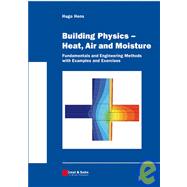
| Preface | |
| Introduction | |
| Subject of the Book | |
| Building Physics | |
| Definition | |
| Criteria | |
| Comfort | |
| Health | |
| Architectural and Material Facts | |
| Economy | |
| Environment | |
| Importance of Building Physics | |
| History of Building Physics | |
| References | |
| Units and Symbols | |
| Heat Transfer | |
| Overview | |
| Conduction | |
| Conservation of Energy | |
| Fourier's Laws | |
| First Law | |
| Second Law | |
| Steady State | |
| What Is It? | |
| One Dimension: Flat Walls | |
| Two Dimensions: Cylinder Symmetry | |
| Two and Three Dimensions: Thermal Bridges | |
| Transient Regime | |
| What is Transient? | |
| Flat Walls, Periodic Boundary Conditions | |
| Flat Walls, Transient Boundary Conditions | |
| Two and Three Dimensions | |
| Convection | |
| Overview | |
| Heat Transfer at a Surface | |
| Convection | |
| Convection Typology | |
| Driving Forces | |
| Type of flow | |
| Calculating the Convective Surface Film Coefficient | |
| Analytically | |
| Numerically | |
| Dimensional Analysis | |
| Values for the Convective Surface Film Coefficient | |
| Walls | |
| Cavities | |
| Pipes | |
| Radiation | |
| Overview | |
| Thermal Radiation | |
| Quantities | |
| Reflection, Absorption and Transmission | |
| Radiant Surfaces | |
| Black Bodies | |
| Characteristics | |
| Radiation Exchange Between Two Black Bodies: The Angle Factor | |
| Properties of Angle Factors | |
| Calculating Angle Factors | |
| Grey Bodies | |
| Characteristics | |
| Radiation Exchange Between Grey Bodies | |
| Colored Bodies | |
| Practical Formulae | |
| Applications | |
| Surface Film Coeffi cients and Reference Temperatures | |
| Overview | |
| Inside Environment | |
| Outside Environment | |
| Steady-state, One-dimension: Flat Walls | |
| Thermal Transmittance and Interface Temperatures | |
| Thermal Resistance of a Non-ventilated Infi nite Cavity | |
| Solar Transmittance | |
| Steady State, Cylindrical Coordinates: Pipes | |
| Steady-state, Two and Three Dimensions: Thermal Bridges | |
| Calculation by the Control Volume Method (CVM) | |
| Thermal Bridges in Practice | |
| Transient, Periodic: Flat Walls | |
| Heat Balances | |
| Problems | |
| References | |
| Mass Transfer | |
| In General | |
| Quantities and Definitions | |
| Saturation Degree Scale | |
| Air and Moisture Transfer | |
| Moisture Sources | |
| Air, Moisture and Durability | |
| Linkages between Mass-and Energy Transfer | |
| Air Transfer | |
| In General | |
| Air Pressure Differences | |
| Wind | |
| Stack Effects | |
| Fans | |
| Air Permeances | |
| Air Transfer in Open-porous Materials | |
| Conservation of Mass | |
| Flow Equation | |
| Air Pressures | |
| One Dimension: Flat Walls | |
| Two- and Three-dimensions | |
| Air Flow Through Permeable Layers, Apertures, Joints, Leaks and Cavities | |
| Flow Equations | |
| Conservation of Mass, Equivalent Hydraulic Circuit | |
| Combined Heat- and Air Transfer | |
| Open-porous Materials | |
| Air Permeable Layers, Joints, Leaks and Cavities | |
| Vapour Transfer | |
| Water Vapour in the Air | |
| Ove | |
| Table of Contents provided by Publisher. All Rights Reserved. |
The New copy of this book will include any supplemental materials advertised. Please check the title of the book to determine if it should include any access cards, study guides, lab manuals, CDs, etc.
The Used, Rental and eBook copies of this book are not guaranteed to include any supplemental materials. Typically, only the book itself is included. This is true even if the title states it includes any access cards, study guides, lab manuals, CDs, etc.